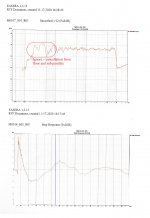Here is a rough sketch of the plans for the PMA60 (have to reload sketch up) - There are a couple of things to note;
1) To minimize its size and keep the 2 x 12" speakers as close as possible to each other, the horn flare covers part of the 12" driver and shares one bolt / screw hole. (see earlier pictures).
2) The material I used was 16mm ply
3) The rear port also serves as a handle or grab point, so there is a small lip at the top of the port to help.
4) When arraying two boxes the DSP settings can be modified with a couple of filters - a 5 to 6 dB shelving filter to adjust the coupling of the 12's and a PEQ to adjust the coupling of the horn at its lower operating range,
1) To minimize its size and keep the 2 x 12" speakers as close as possible to each other, the horn flare covers part of the 12" driver and shares one bolt / screw hole. (see earlier pictures).
2) The material I used was 16mm ply
3) The rear port also serves as a handle or grab point, so there is a small lip at the top of the port to help.
4) When arraying two boxes the DSP settings can be modified with a couple of filters - a 5 to 6 dB shelving filter to adjust the coupling of the 12's and a PEQ to adjust the coupling of the horn at its lower operating range,




